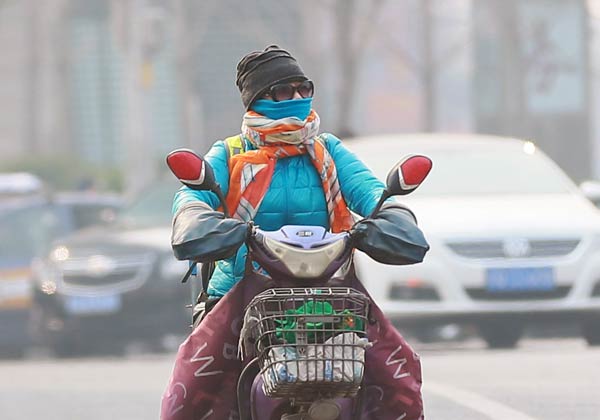|
 |
|
A mask-wearing resident rides an electric bike on the Dongzhimen Overpass in Beijing on Monday. The air quality index in the capital reached 320, indicating severe pollution. ZOU HONG / CHINA DAILY |
 |
 |
Beijing and neighboring Tianjin and Hebei province see more severe air pollution than the rest of the nation, the Ministry of Environmental Protection said in a report released on Tuesday.
Of the country's 20 most polluted cities, as many as 11 lie in the Beijing-Tianjin-Hebei city cluster, with seven of them among the 10 worst, according to 2013 air quality monitoring data provided by the environmental watchdog.
Many of the cities, including Xingtai, Shijiazhuang, Tangshan and Baoding, mostly in Hebei province, saw 40 percent of their days seriously polluted, it said.
According to the annual report, only 60.5 percent of the days in 74 major cities monitored nationwide meet the national standard, while 22.9 percent of the days are considered polluted, 8 percent seriously polluted and 8.6 percent very severely polluted.
The annual intensity of PM2.5 - particles smaller than 2.5 micrometers in diameter - nationwide averaged 72 micrograms per cubic meter across the country in 2013, it said.
Experts said controlling the sources is the key for reining in pollution.
Ma Jun, director of the Institute of Public and Environmental Affairs, an environmental NGO, said finding the sources of pollution is key to the fight.
"It's necessary to conduct effective supervision of the key pollution sources across the country and have them release real-time emissions data," Ma said.
Yang Fuqiang, senior adviser on climate and energy policy at the Natural Resources Defense Council, said that the high consumption of coal seriously contributes to smog.
Yang suggested cleaner coal and more effective use of energy to realize a significant decline in total coal consumption by 2017.
The ministry said that, in addition to PM2.5, which is harmful to the lungs and heart, PM10, nitrogen dioxide and ozone all contribute to the country's notorious pollution.
The performance of the 13 monitored cities in the Beijing-Tianjin-Hebei region was 23 percent lower than the national average, the ministry said. PM2.5 and PM10 are the major pollutants, with an annual average intensity of PM2.5 reaching 106 micrograms per cu m, and PM10 at 181 micrograms per cu m.
The annual intensity of sulfur dioxide is 69 micrograms per cu m, with nitrogen dioxide at 51 micrograms per cu m in the area.
The 10 cities with the most serious pollution last month were Xingtai, Shijiazhuang, Handan, Tangshan, Baoding, Jinan, Hengshui, Xi'an, Langfang and Zhengzhou, the ministry said.
The cleanest air was found in Haikou, Zhoushan, Lhasa, Fuzhou, Huizhou, Zhuhai, Shenzhen, Xiamen, Lishui and Guiyang.
The frequent occurrence of notoriously smoggy days has prompted authorities to take serious action against pollution largely because urban dwellers are widely unhappy about it.
Even though spring and summer see less frequent and less severe pollution compared to autumn and winter, Beijing has seen serious pollution in recent days. A new wave of smog has shrouded the Chinese capital since Sunday, and might persist for a few days, according to the Beijing Environmental Protection Bureau.
The pollution is the result of a low-pressure system in the atmosphere and is likely to last through Thursday, it said.
The authorities advise members of the public to stay indoors on heavily polluted days to reduce health hazards.
zhengxin@chinadaily.com.cn
